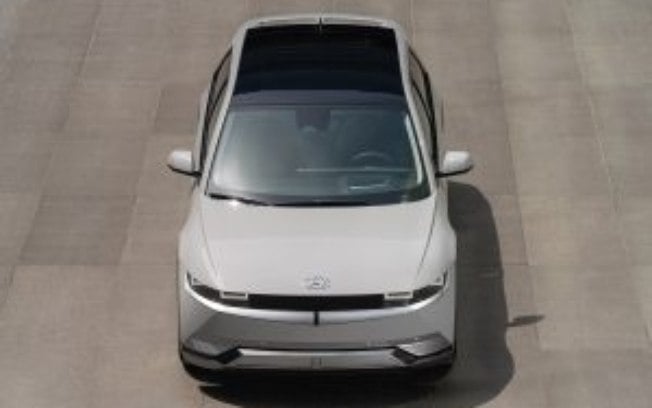A stylish arrival
Hyundai IONIQ 5, scheduled for the second half of the year in Brazil, shows why it is racking up awards all over the world
by Marcelo Palomino
Autocosmos.com/Chile
Exclusive in Brazil for Auto Press
The name Hyundai IONIQ 5 sounds familiar to anyone who follows the automotive world at all. That’s because, for some years now, the South Korean brand has been investing in the sub-brand that names its entire range of electric cars. And far removed from the hybrids or adapted electrics that populate today’s market, the IONIQ range is characterized by its models that were born electric from the drawing board. They feature cutting-edge technology, a dedicated chassis, a high level of development and a bold design full of personality. Not by chance, it won several World Car of the Year categories in 2022: Best Car, Best Electric Car and Best Style, as well as having Hyundai’s head of design, the Belgian-Peruvian Luc Donckerwolke, take the Automotive Personality of the Year award. The model will be the first 100% electric to be brought by Hyundai in its new role as the brand’s absolute parent company in Brazil. And it will be part of a new range that will include the current compacts HB20 and Creta as well as the Tucson, Palisade and soon Santa Fe and Kona.
The IONIQ 5 has been making headlines since it appeared as a prototype in 2019, still under the name 45 EV Concept. And it has caused a stir in the markets where it is launched – as is happening now in Chile and should happen in Brazil in 2024. Hyundai presents the model as a CUV, or Crossover Utility Vehicle, but the IONIQ 5 is clearly a mid-size hatchback, which has been very successful in the markets where it is sold. Almost 200,000 units have been delivered worldwide since its official presentation at the beginning of 2021. It is manufactured at the Ulsan plant in South Korea and faces models from generalist brands such as the Ford Mustang Mach-E, Kia EV6, Renault Mégane E-Tech, Nissan Ariya and Volkswagen ID.4. In Brazil, it will have rivals currently priced at around R$300,000,such as Nissan Leaf and Chevrolet Bolt EUV.
The IONIQ 5 debuts the e-GMP modular platform, specifically for electric cars, which allows models of different sizes and segments to be built, using different battery sizes and offering single or dual engines, with front or all-wheel drive. So much so that it already serves as the basis for other models, such as the IONIQ 6, the Kia EV range and the Genesis brand’s 100% electric models. This architecture is designed to work at 800 volts, which allows for high performance from the electric motor and charging phases at very high powers with little loss. It also has bidirectional charging, so it can also power external electrical devices. Finally, the design follows the well-established logic of installing the battery in the floor of the cabin, which frees up space for the occupants and lowers the center of gravity, which increases the vehicle’s stability.
The IONIQ 5 has several configurations, depending on the market. The version offered in Chile and which will probably be brought to Brazil is the one with an intermediate capacity battery, with 72.6 kWh – there is also a smaller one, with 58 kWh and a range of 384 km, and a slightly larger one, with 77.4 kWh, launched just to meet the fetish of a range of over 500 km – in the WTLP cycle it reaches 507 km. The smaller battery always powers versions with a 170 hp engine and rear-wheel drive and the larger ones can equip models with a 214 hp engine and rear-wheel drive or two engines that add up to 325 hp – 101 hp at the front, 214 hp at the rear – with all-wheel drive. Torque is 35.7 kgfm in the rear-wheel drive models and 61.7 kgfm in the AWD.
The battery pack is liquid-cooled, and the efficiency of this system allows ultra-fast DC charging of up to 350 kW (in Brazil, the most powerful chargers have 150 kW), which would take just 18 minutes to go from 10 to 80% charge. It only takes 5 minutes to recover 100 km of range, which would take around 60 minutes with a 50 kW charger. With an 11 kW domestic wallbox, it takes 7 hours and 10 minutes to take the charge from 10 to 100%.
The IONIQ’s appearance is misleading when it comes to assessing its size and capacity. Despite having the proportions of a compact hatchback, it has the dimensions of a large vehicle. It measures 4.64 meters in length, 1.89 m in width, 1.61 mm in height and has a remarkable 3.00 m wheelbase. In other words: it really is a crossover with the space of a medium SUV. By way of comparison, it is smaller than the BMW X3 but has a longer wheelbase than the X5. It therefore offers good rear space and a large trunk with a capacity of 527 liters – in addition to the compartment under the hood, with up to 57 additional liters.
The design adds a series of elements that give it a modern and futuristic look. These include the bumpers with various geometric designs, the pixelated LEDs that surround the LED cannons in the front optical clusters, the 256 small LEDs, also pixelated, that make up the rear lights, the small, closed grille in glossy black, the large 20-inch wheels, the retractable door handles hidden in the bodywork and the sharply angled creases on the sides and hood.
Interiorly, Hyundai’s CUV features a very minimalist design, with no physical controls or buttons in sight, which enhances the user’s digital experience. This includes a 12.3-inch cluster coupled to the multimedia center with a 12.3-inch screen. The system, of course, is compatible with Android Auto and Apple CarPlay and has a Bose sound system. The interior space stands out for its modularity. The center console is movable – it can slide 14 cm – and Hyundai has reduced the thickness of the front seats by 30%, to increase the space for the passengers in the second row, who enjoy a completely flat floor. The front seats and steering wheel are adjustable and heated.
And in terms of safety, the IONIQ 5 comes with six airbags, parking sensors, a reversing camera with guides and the Hyundai Sense package, with forward collision alert with autonomous braking, blind spot alert, lane keeping and tracking, rear cross traffic alert, adaptive cruise control and automatic high beam, among other features. According to Hyundai, many interior elements, such as seat and door coverings, headliner, floor and armrests, use ecological materials of sustainable origin, such as recycled pet bottles, yarns of plant origin, natural wool yarns, eco-leather processed with plant extracts and biological paint with plant extracts (Text by Marcelo Palomino, from Autocosmos Chile, and exclusive in Brazil for Auto Press. Disclosure photos).
Driving impressions
Beyond expectation
by Jorge Beher
Autocosmos.com/Chile
Exclusive in Brazil for Auto Press
The presentation of the IONIQ 5 took place at the Codegua National Autodrome. 70 km south of Santiago de Chile. And the transformation that the look undergoes when seen at night, under floodlights, and in a real environment with daylight is very striking. The strangest thing, however, is getting used to the idea that it is 4.65 meters long and has a 3.00 m wheelbase. It’s like a vitaminized version of a mid-size hatchback. It’s as if a Hyundai i30 suddenly gains 10% in size in all directions.
The wheels are giant and the wide wheel arches set them off from the body with geometric cuts and clean planes. This really gives the car a very special futuristic vibe, apart from the fact that the design reference is a car from almost five decades ago, the Hyundai Pony, an Italdesign Giugiaro original. That says a lot about good design, because when something is timeless, it can always look contemporary and Giugiaro’s ideas are a bit like that.
The intricate details are also interesting. The optical clusters designed on the basis of small pixels, as if they were a mosaic, the theme of the slits, the Z crease in the doors and the cozy, spacious and softly shaped interior. The controls with large anodized buttons and the textures with ecological materials, but without looking impoverished. To talk about the effects of ambient light, the concave doors and the center console that looks more like an island that you can move to the rear or front seats.
On the move, the IONIQ 5 is very pleasant. Spacious, tremendously quiet and a design that generates calm and well-being. At the wheel of the most luxurious version, Limited AWD, powered by two electric motors that add up to 325 hp and 61.7 kgfm, you can do zero to 100 km/h in 5.2 seconds. But what stands out most when driving is the sense of balance. Korean cars have become much better dynamically and no longer seem so inconsistent or fickle. The CUV rests very well on its suspension and the steering has a well-measured weight. The feeling of space is further enhanced by the concave doors, the light colors of the upholstery and the panoramic roof.
Consumption on the highway remained between 5 and 7 km/kWh. It’s not low, but given the size and weight of the car – around 2 tons – it’s acceptable. Considering the model’s energy reserves, it’s an electric car whose range is easy to manage. In the case of the AWD versions, the expectation is to reach 430 km. The single-motor version can reach 480 km in ideal conditions.
The IONIQ 5 is not a sports car, but it has the torque and acceleration of one. And what’s most interesting are two extra tricks that help camouflage its weight and bulk to make it look a little sportier. The first is the HTrac traction system, which emulates a mechanical AWD system, but with two independent electric motors. This means that the car can mitigate weight transfers by applying traction to one axle or the other, making it much more stable and balanced. The second has to do with the operation of the regenerative braking system, which greatly helps decelerate when entering a corner, reducing the stress on the brakes.
These elements are not new for an electric car, but in the IONIQ 5 they are enhanced and allow the driver to rely on them to extract more aggression from the car. Another characteristic of an electric car appears on the straight: the speed ceiling is only 175 km/h. In other words: there are still 150 meters of straight to go and it’s already at its maximum. From there to the corner entrance is a long yawn. All in all, the IONIQ 5 manages to be very interesting, with the sum of its parts. It’s a great car and a great experience (by Jorge Beher, from Autocosmos Chile, and exclusive in Brazil for Auto Press).
The post The electric of fashion appeared first on MotorDream.


